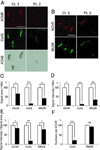Specific binding of collagen Q to the neuromuscular junction is exploited to cure congenital myasthenia and to explore bases of myasthenia gravis
- PMID: 22981737
- PMCID: PMC4405266
- DOI: 10.1016/j.cbi.2012.08.020
Specific binding of collagen Q to the neuromuscular junction is exploited to cure congenital myasthenia and to explore bases of myasthenia gravis
Abstract
Acetylcholinesterase (AChE) at the neuromuscular junction (NMJ) is anchored to the synaptic basal lamina via a triple helical collagen Q (ColQ) in the form of asymmetric AChE (AChE/ColQ). The C-terminal domain of ColQ binds to MuSK, the muscle-specific receptor tyrosine kinase, that mediates a signal for acetylcholine receptor (AChR) clustering at the NMJ. ColQ also binds to heparan sulfate proteoglycans including perlecan. Congenital defects of ColQ cause endplate AChE deficiency. A single intravenous administration of adeno-associated virus serotype 8 (AAV8)-COLQ to Colq-/- mice rescued motor functions, synaptic transmission, and the ultrastructure of NMJ. We also injected AAV1-COLQ-IRES-EGFP to the left tibialis anterior and observed colocalization of AChE/ColQ at all the examined NMJs of the non-injected limbs. Additionally, injection of purified recombinant AChE/ColQ protein complex into gluteus maximus accumulated AChE in non-injected forelimbs. These observations suggest that the tissue-targeting signal of ColQ can be exploited to specifically deliver the transgene product to the target tissue. MuSK antibody-positive myasthenia gravis (MG) accounts for 5-15% of autoimmune MG. As AChR deficiency is typically mild and as cholinesterase inhibitors are generally ineffective or worsen myasthenic symptoms, we asked if the patient's MuSK-IgG interferes with binding of ColQ to MuSK. In vitro overlay of AChE/ColQ to muscle sections of Colq-/- mice revealed that MuSK-IgG blocks binding of ColQ to the NMJ. In vitro plate-binding of MuSK to ColQ disclosed that MuSK-IgG exerts a dose-dependent block of MuSK-ColQ interaction. In addition, passive transfer of MuSK-IgG to mice reduced the size and density of ColQ to ∼10% of controls and had a lesser effect on the sizes and densities of AChR and MuSK. Elucidation of molecular mechanisms of specific binding of ColQ to the NMJ enabled us to ameliorate devastating myasthenic symptoms of Colq-/- mice and to reveal bases of anti-MuSK MG.
Copyright © 2012 Elsevier Ireland Ltd. All rights reserved.
Figures






Similar articles
-
Collagen Q is a key player for developing rational therapy for congenital myasthenia and for dissecting the mechanisms of anti-MuSK myasthenia gravis.J Mol Neurosci. 2014 Jul;53(3):359-61. doi: 10.1007/s12031-013-0170-x. J Mol Neurosci. 2014. PMID: 24234034 Review.
-
Anti-MuSK autoantibodies block binding of collagen Q to MuSK.Neurology. 2011 Nov 15;77(20):1819-26. doi: 10.1212/WNL.0b013e318237f660. Epub 2011 Oct 19. Neurology. 2011. PMID: 22013178 Free PMC article.
-
Protein-anchoring strategy for delivering acetylcholinesterase to the neuromuscular junction.Mol Ther. 2012 Jul;20(7):1384-92. doi: 10.1038/mt.2012.34. Epub 2012 Feb 28. Mol Ther. 2012. PMID: 22371845 Free PMC article.
-
[Anti-MuSK antibodies in myasthenia gravis block binding of collagen Q to MuSK].Rinsho Shinkeigaku. 2012;52(11):1306-8. doi: 10.5692/clinicalneurol.52.1306. Rinsho Shinkeigaku. 2012. PMID: 23196600 Japanese.
-
Roles of collagen Q in MuSK antibody-positive myasthenia gravis.Chem Biol Interact. 2016 Nov 25;259(Pt B):266-270. doi: 10.1016/j.cbi.2016.04.019. Epub 2016 Apr 24. Chem Biol Interact. 2016. PMID: 27119269 Review.
Cited by
-
A COLQ Missense Mutation in Sphynx and Devon Rex Cats with Congenital Myasthenic Syndrome.PLoS One. 2015 Sep 1;10(9):e0137019. doi: 10.1371/journal.pone.0137019. eCollection 2015. PLoS One. 2015. PMID: 26327126 Free PMC article.
-
The efficacy and safety of efgartigimod for refractory myasthenia gravis: a systematic review and meta-analysis.Eur J Med Res. 2025 Aug 20;30(1):775. doi: 10.1186/s40001-025-03057-6. Eur J Med Res. 2025. PMID: 40830529 Free PMC article.
-
Neuromuscular Junction Impairment in Amyotrophic Lateral Sclerosis: Reassessing the Role of Acetylcholinesterase.Front Mol Neurosci. 2016 Dec 27;9:160. doi: 10.3389/fnmol.2016.00160. eCollection 2016. Front Mol Neurosci. 2016. PMID: 28082868 Free PMC article. Review.
-
Fell-Muir Lecture: Heparan sulphate and the art of cell regulation: a polymer chain conducts the protein orchestra.Int J Exp Pathol. 2015 Aug;96(4):203-31. doi: 10.1111/iep.12135. Epub 2015 Jul 15. Int J Exp Pathol. 2015. PMID: 26173450 Free PMC article.
-
B cells in the pathophysiology of myasthenia gravis.Muscle Nerve. 2018 Feb;57(2):172-184. doi: 10.1002/mus.25973. Epub 2017 Sep 30. Muscle Nerve. 2018. PMID: 28940642 Free PMC article. Review.
References
-
- Donger C, Krejci E, Pou Serradell A, Eymard B, Bon S, Nicole S, Chateau D, Gary F, Fardeau M, J M, Guicheney P. Mutation in the human acetylcholinesterase-associated collagen gene, COLQ, is responsible for congenital myasthenic syndrome with end-plate acetylcholinesterase deficiency (Type Ic) Am. J. Hum. Genet. 1998;63:967–975. - PMC - PubMed
Publication types
MeSH terms
Substances
Grants and funding
LinkOut - more resources
Full Text Sources
Other Literature Sources
Research Materials

